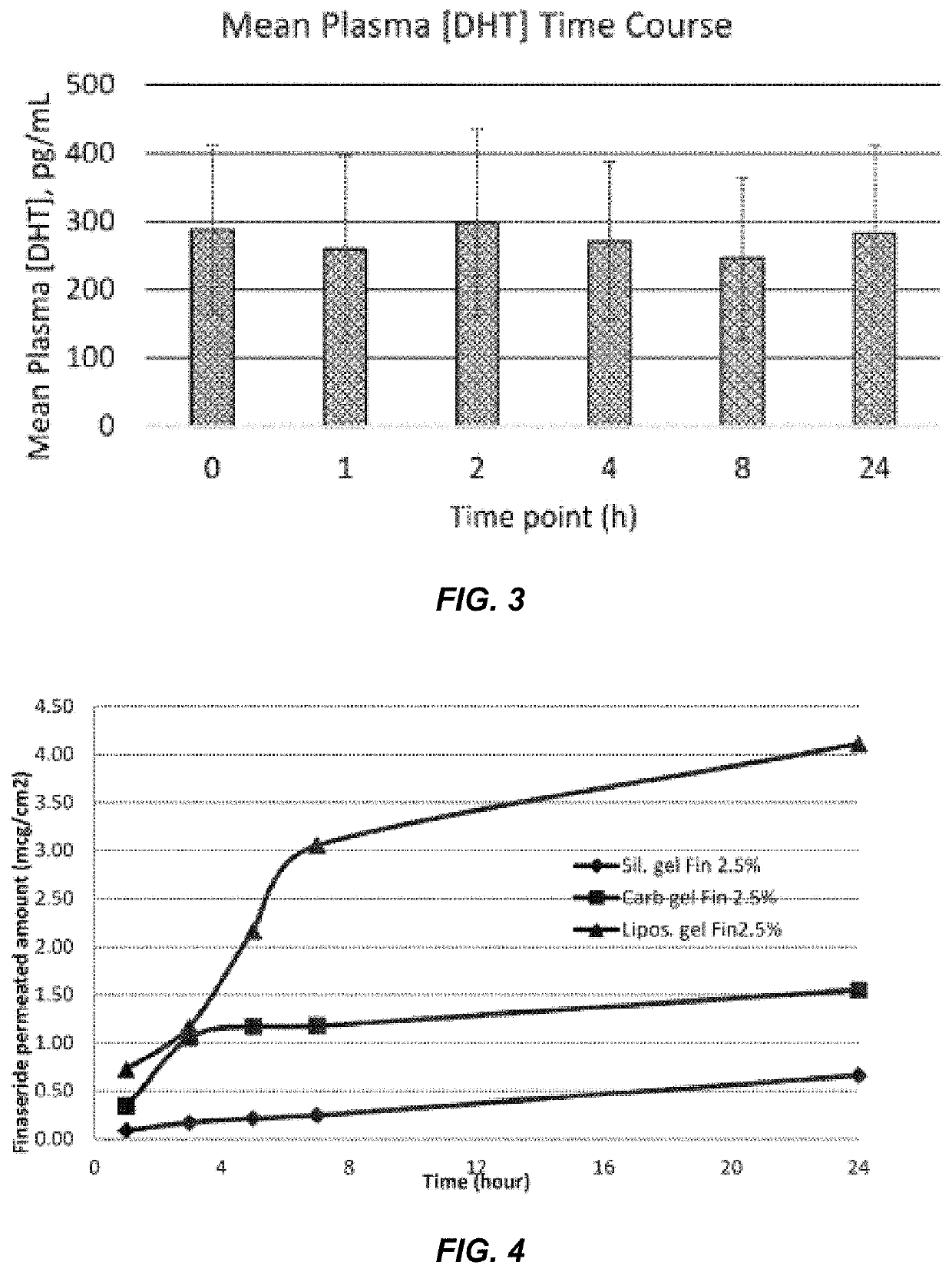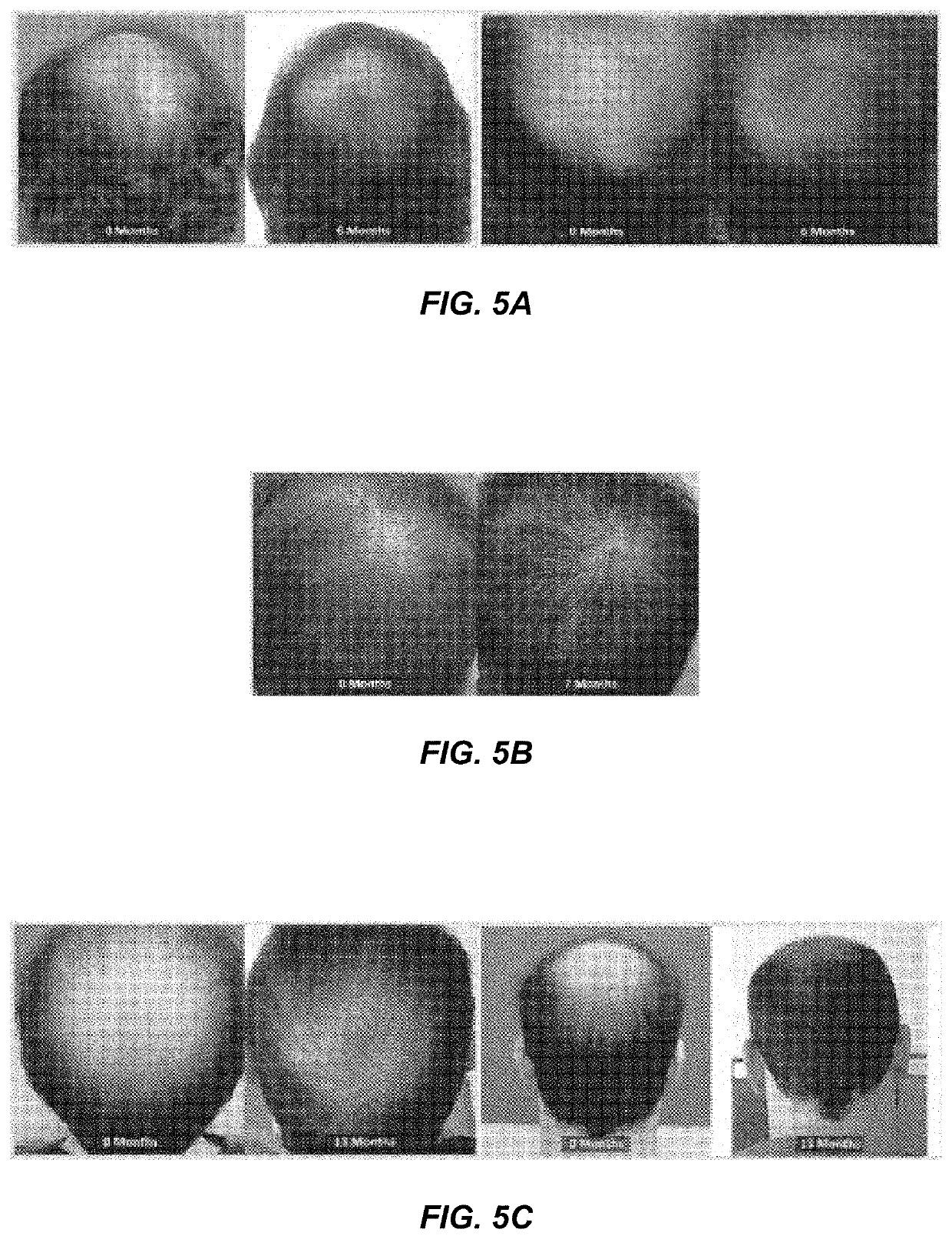Topical formulations for treating dermatological disorders including male pattern baldness
a dermatological disease and formulation technology, applied in the field of formulations for treating dermatological diseases and disorders, can solve the problems of reducing the nutritional supply of hair shafts, reducing the number of patients, so as to reduce the serum concentration of -reductase inhibitors, prevent hair loss, and delay or reverse hair loss.
- Summary
- Abstract
- Description
- Claims
- Application Information
AI Technical Summary
Benefits of technology
Problems solved by technology
Method used
Image
Examples
example 1
on of 2.5% w / w Finasteride Topical Composition
[0096]A sanitized turbo-emulsifier was charged with water, followed by Lecinol S-10. The resultant mixture was stirred at high speed for 10 minutes at ambient temperature. While maintaining stirring, the mixture was warmed to 70° C. and stirred for an additional 60 minutes at 70° C. Carbopol Ultrez® 21 was added and the resultant mixture was stirred at medium speed at 70° C. for 10 minutes and allowed to stand at a temperature of 70° C. for 30 minutes, ensuring the acrylate polymer was solvated. To the mixture was added a solution of finasteride in 1,3-propane diol and the resultant mixture was stirred at high speed for 10 minutes at 70° C. While maintaining stirring, the mixture was allowed to cool to 30° C. and Neofect® 403, phenoxyethanol, Silwax® WS, and dimethyl isosorbide were added sequentially. To the resultant homogeneous mixture was added 2-amino-2-methylpropan-1-ol followed by stirring at high speed for 10 minutes. Thereafter,...
example 2
on of Gel Base
[0097]A sanitized turbo-emulsifier was charged with water, followed by Lecinol S-10. The resultant mixture was stirred at high speed for 10 minutes at ambient temperature. While maintaining stirring, the mixture was warmed to 70° C. and stirred for an additional 60 minutes at 70° C. Carbopol Ultrez® 21 was added and the resultant mixture was stirred at medium speed at 70° C. for 10 minutes and allowed to stand at a temperature of 70° C. for 30 minutes, to achieve solvation of the acrylate polymer. While maintaining stirring, the mixture was allowed to cool to 30° C. and Nefect® 403, phenoxyethanol, Silwax® WS, and dimethyl isosorbide were added sequentially. To the resultant homogeneous mixture was added 2-amino-2-methylpropan-1-ol followed by stirring at high speed for 10 minutes. Gransil PSQ® was added to the mixture, followed by 10 minutes of high speed stirring to afford a homogeneous gel. The final concentration of each respective component is shown in Table 2 bel...
example 3
on of 2.5 w / w Finasteride Topical Gel Via Compounding
[0098]A mixture of finasteride (2.5 g) and the liposomal gel base of Example 2 (2.5 g) was levigated (i.e., milled together) at ambient temperature in an electronic mortar and pestle (e.g., Unguator E / S, Galenova, Inc., Saint-Hyacinthe, QC, Canada) for 5 minutes. Additional liposomal gel base (95 g) was added portion-wise over 10 minutes and the levigation was continued until a visually-homogeneous mixture is obtained.
Pharmacokinetic Analysis of Subjects Dosed with 2.5% w / w Finasteride Topical Composition
[0099]A pharmacokinetic (PK) and pharmacodynamic (PD) clinical study was performed to ascertain whether the topical liposomal formulation of Example 3 (i.e., a 2.5% w / w finasteride topical liposomal composition) leads to modest systemic exposure of finasteride in human subjects, and to determine whether daily application of the topical liposomal formulation of Example 1 to the scalp for three weeks leads to an attenuation of the r...
PUM
| Property | Measurement | Unit |
|---|---|---|
| water-soluble | aaaaa | aaaaa |
| 5-α- | aaaaa | aaaaa |
| concentration | aaaaa | aaaaa |
Abstract
Description
Claims
Application Information
 Login to View More
Login to View More - R&D
- Intellectual Property
- Life Sciences
- Materials
- Tech Scout
- Unparalleled Data Quality
- Higher Quality Content
- 60% Fewer Hallucinations
Browse by: Latest US Patents, China's latest patents, Technical Efficacy Thesaurus, Application Domain, Technology Topic, Popular Technical Reports.
© 2025 PatSnap. All rights reserved.Legal|Privacy policy|Modern Slavery Act Transparency Statement|Sitemap|About US| Contact US: help@patsnap.com



